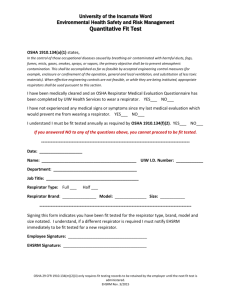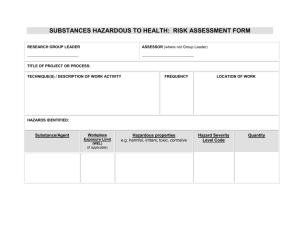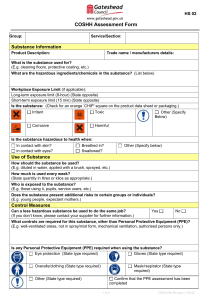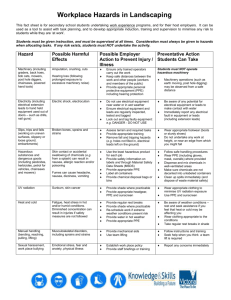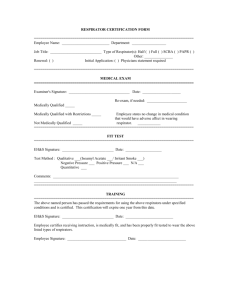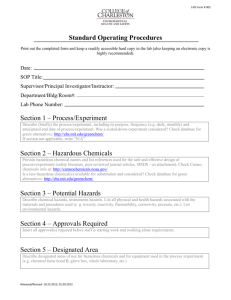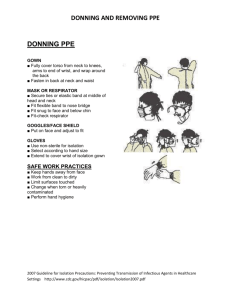F-010 40-Hour HAZWOPER Post
advertisement
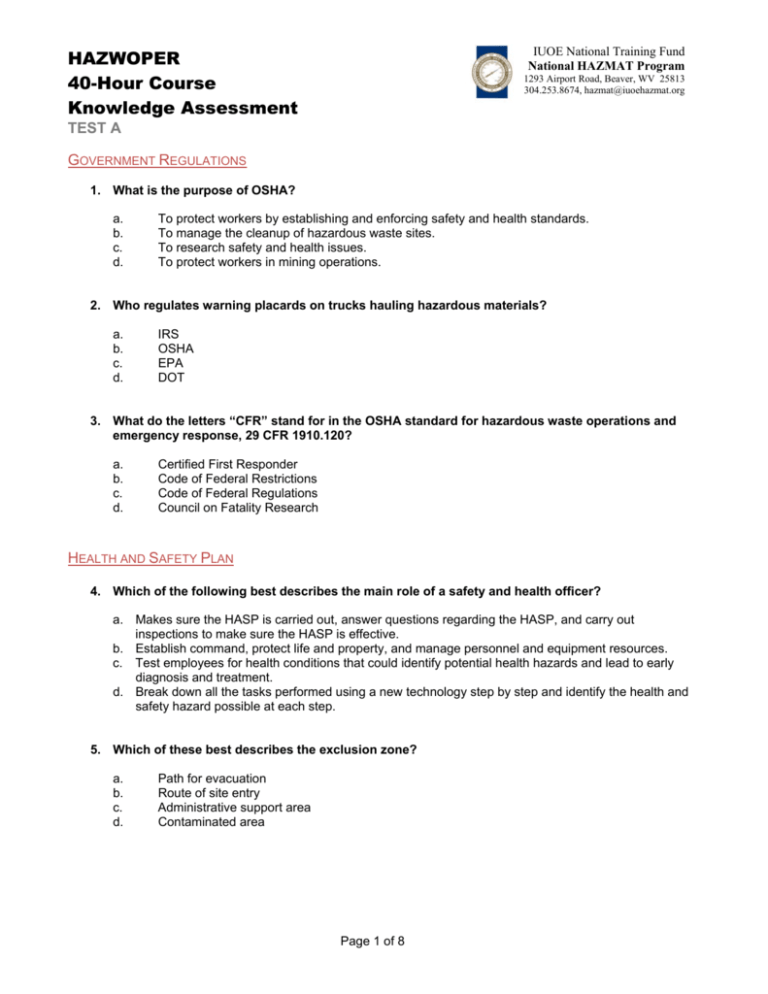
HAZWOPER 40-Hour Course Knowledge Assessment IUOE National Training Fund National HAZMAT Program 1293 Airport Road, Beaver, WV 25813 304.253.8674, hazmat@iuoehazmat.org TEST A GOVERNMENT REGULATIONS 1. What is the purpose of OSHA? a. b. c. d. To protect workers by establishing and enforcing safety and health standards. To manage the cleanup of hazardous waste sites. To research safety and health issues. To protect workers in mining operations. 2. Who regulates warning placards on trucks hauling hazardous materials? a. b. c. d. IRS OSHA EPA DOT 3. What do the letters “CFR” stand for in the OSHA standard for hazardous waste operations and emergency response, 29 CFR 1910.120? a. b. c. d. Certified First Responder Code of Federal Restrictions Code of Federal Regulations Council on Fatality Research HEALTH AND SAFETY PLAN 4. Which of the following best describes the main role of a safety and health officer? a. Makes sure the HASP is carried out, answer questions regarding the HASP, and carry out inspections to make sure the HASP is effective. b. Establish command, protect life and property, and manage personnel and equipment resources. c. Test employees for health conditions that could identify potential health hazards and lead to early diagnosis and treatment. d. Break down all the tasks performed using a new technology step by step and identify the health and safety hazard possible at each step. 5. Which of these best describes the exclusion zone? a. b. c. d. Path for evacuation Route of site entry Administrative support area Contaminated area Page 1 of 8 6. How many workers make up the initial entry team that performs the on-site assessment and surveys needed to revise the first draft of the HASP? a. b. c. d. One worker to minimize the number of persons exposed to unknown hazards. Two workers: The buddy system is standard operating procedure when working in a hazardous area. Four workers: two who are fully protected with PPE and respirators and two outside support persons also in PPE prepared to assist in an emergency. Three workers: two who are fully protected with PPE and respirators and one outside support person also in PPE prepared to assist in an emergency. TOXICOLOGY 7. In the dose response equation, C x T = Dose, what does the T represent? a. b. c. d. Toxicity Threshold Exposure Time Temperature 8. Which of these best describes the term “acute exposure”? a. b. c. d. Many exposures to a substance over time A single exposure that leads to injury or illness Limited exposure to a substance Permanent damage due to exposure 9. Which of these best describes the term “target organs”? a. b. c. d. Body organs most likely to be affected by toxic substances Body parts that shield the body from the highest exposure Parts of the body that are most sensitive to chemical exposure Body organs that protect the body from harm HAZARD COMMUNICATION 10. Which of these best describes the employer’s main responsibility to protect workers under OSHA’s Hazard Communication Standard? a. b. c. d. Investigate the hazards of commonly used chemicals Train workers in the hazards of the chemicals they are using and how to protect themselves Label drums containing hazardous waste Point out jobs with frequent chemical exposure 11. In this NFPA label there is a 3 in the red diamond, a 1 in the blue diamond, a 0 in the yellow diamond and the white diamond is empty. Which of the following best describes the information this NFPA label conveys? a. b. c. d. Extreme danger; very flammable (FP below 73°F); may react if heated or mixed with water Normal health hazards; combustible if heated (FP above 200° F); not reactive Use caution due to possible health hazard; flammable (FP below 100° F); stable, not reactive Use caution due to possible health hazard; flammable (FP below 100° F); may react if heated or mixed with water; acid. Page 2 of 8 3 1 0 MATERIAL SAFETY DATA SHEETS 12. Which of these best describes the main purpose of a material safety data sheet (MSDS)? a. b. c. d. Tells workers how to set up decontamination line stations Trains workers in how to inspect, stage, handle, and open drums Informs workers about hazards posed by that chemical and how the product can be safely used Trains workers how to properly inspect and don their respirator and PPE 13. What is the flash point of a flammable liquid according to OSHA? a. b. c. d. Less than 100 degrees F Greater than 75 degrees F No more than 32 degrees F Exactly 99 degrees F MONITORING 14. Which of the following instruments could be used to perform two of the three required pre-entry tests? a. b. c. d. Combustible gas and oxygen indicator Radiation detector Flame ionization detector Photoionization detector 15. At what average noise levels during an eight-hour workday are you required to wear hearing protection? a. b. c. d. 80 dB or more 90 dB or more 85 dB or more 95 dB or more 16. What tends to be one of the biggest limitations of direct reading instruments? a. b. c. d. They are rarely sensitive enough to measure small concentrations. They require a lot of training to operate. They are heavy and not very portable. They are very expensive. MEDICAL SURVEILLANCE PROGRAM 17. Which of these best describes the overall purpose of a medical surveillance program? a. b. c. d. Assesses and monitors workers’ health to assure their health is not being damaged by on-site hazardous substances Assists workers with handling high stress levels from handling hazardous waste Determines which workers may smoke Evaluates a worker’s hearing status 18. Which of these types of workers would be covered by the medical surveillance program? a. b. c. d. Site visitors with no exposure Workers who have no exposure to hazardous substances Workers who may be exposed to hazardous substances Workplaces next to the site Page 3 of 8 19. How are your rights to privacy for your medical records protected in the medical surveillance plan? a. b. c. d. Your representatives can receive information about an injury or illness, but personal information is not disclosed. Employers must remove your name from forms before providing any data to persons who do not have access rights under the standard. Both A and B are true, and your doctor is NOT to reveal any specific findings or diagnoses not directly related to employment conditions. Both A and B are true, and your doctor CAN reveal any specific findings or diagnoses referenced in your medical history. RESPIRATORY PROTECTION 20. What is the best description of a respirator fit test? a. b. c. d. Test of how well a respirator fits against a person’s face Test of a worker’s current physical fitness Plan to check the proper storage and handling of respirators Progress report on how the job site meets the OSHA respirator standard 21. Which of the following types of respirators would be the best to use in an IDLH (immediate danger to life and health) atmosphere? a. b. c. d. Air purifying respirator (APR) Dust mask Powered air purifying respirator (PAPR) Self-contained breathing apparatus (SCBA) 22. Which of these types of respirators offer you the most protection? a. b. c. d. Dust mask Positive-pressure supplied air respirator Powered air purifying respirator (PAPR) Air purifying respirator (APR) 23. Which one of the following best describes what assigned protection factor (APF) means? a. b. c. d. How much air the cylinder can store What medical tests are necessary to wear the respirator How protective the respirator is What color cartridges must be used PERSONAL PROTECTIVE EQUIPMENT 24. Which personal protective equipment level includes a fully encapsulating chemical protective clothing (CPC) suit? . a. b. c. d. Level B Level A Level C Level D Page 4 of 8 25. Which personal protective equipment level is the minimum level for entry into unknown conditions? . a. b. c. d. Level D Level C Level A Level B 26. Which personal protective equipment level does not include respiratory protection? a. b. c. d. Level D Level C Level B Level A DECONTAMINATION 27. What is the zone where decon facilities should be located on a job site? a. e. c. d. Exclusion zone Evacuation zone Contamination reduction zone Support zone 28. Which of these best describes the correct order of four example decontamination stations? a. b. c. d. 1) tape removal, 2) glove and boot rinse, 3) glove and boot wash, 4) equipment drop 1) equipment drop, 2) tape removal, 3) glove and boot wash, 4) glove and boot rinse 1) glove and boot wash, 2) glove and boot rinse, 3) equipment drop, & 4) tape removal 1) equipment drop, 2) glove and boot wash, 3) glove and boot rinse, 4) tape removal 29. Which of these would be the best way to determine whether the decon line is working well in decontaminating PPE? a. b. c. d. Ask the workers. Look for stained surfaces. Review the decontamination plan. Take a wipe sample of the PPE and test it. RADIATION 30. Select the choice below that lists the radiation types in order from highest penetrating power to least penetrating power. a. b. c. d. Alpha particles, beta particles, gamma rays Gamma rays, alpha particles, beta particles Gamma rays, beta particles, alpha particles All three types have the same penetrating power. 31. You are standing 2 feet from a gamma radiation source; the dose rate you are receiving is 20 mrem/hr. If you can use tools to increase your distance from 2 feet to 4 feet while you complete your task, what will be the dose rate you receive at 4 feet? a. b. c. d. 20 mrem/hr 10 mrem/hr 2 mrem/hr 5 mrem/hr Page 5 of 8 32. Which of the following is not a strategy for minimizing radiation dose to workers at a radiation site? a. b. c. d. Have tools ready before entering the radiation area. Use as few workers as possible. Consider doing a test run of the job. Use experienced workers. HEAT AND COLD STRESS 33. What heat stress disorder causes fatigue, clammy moist skin, headache, and weakness? a. b. c. d. Heat cramps Frost bite Heat stroke Heat exhaustion 34. What is the most serious heat stress disorder? a. b. c. d. Heat cramps Heat stroke Pain spasms Heat exhaustion 35. Which of these is most likely to result in hypothermia? a. b. c. d. Dry, cloudy day at 40 degrees F High humidity at 85 degrees F Tropical storm with heavy rains at 65 degrees F Drenching, wind-driven rain at 40 degrees F BLOODBORNE PATHOGENS 36. Which of these is the most likely to expose a person to bloodborne disease? a. b. c. d. Using a respirator that has not been cleaned properly Working in a decontamination line Cleaning up blood-soaked material without using universal precautions Wearing PPE that has been worn by someone else 37. Which of the following describes a universal precautions approach to infection control? a. b. c. d. All human blood and other infectious materials are treated as if they were infectious. All workers are periodically tested for a wide range of disease. All workers are required to receive vaccinations to prevent disease. None of the above. EMERGENCY RESPONSE 38. Which of the following is an example of a disaster? a. b. c. d. An overturned, leaking tanker truck A fire at a hospital An accidental chemical release at a fertilizer plant Major flooding throughout the Midwestern United States Page 6 of 8 39. Which of these is the MOST important in planning for an event that may call for emergency medical care? a. b. c. d. Storing enough bandages Making arrangements with the nearest emergency care facility Providing drinking water Maintaining the first aid kit DRUM HANDLING 40. Which of these signs indicates that a drum is under pressure? a. b. c. d. Leaks Swelling Decay Open lid 41. Which of these is a potential danger of moving a drum that contains shock-sensitive materials? a. b. c. d. Contents could give off a bad odor. Contents may leak. It may explode. Contents may swell. 42. Which one of the following would require moving hazardous waste from one drum to a new drum? a. b. c. d. The first drum is sealed. The first drum is leaking or deteriorated. The first drum is properly marked. The first drum has no labeling. CONFINED SPACE 43. Which of these describes a confined space? a. b. c. d. Has limited means for entry or exit Has a normal size door Is designed for continuous occupancy Has many entries 44. Which of these describes a permit-required confined space? a. b. c. d. A confined space that has no health or safety hazards A confined space that has a toxic atmosphere A confined space that does not have a toxic atmosphere A confined space that does not contain a material that could suffocate a person who goes in 45. Which of these best describes an oxygen-deficient atmosphere in a confined space? a. b. c. d. 19.5percent oxygen Less than 19.5 percent oxygen 20percent oxygen 50percent oxygen Page 7 of 8 HAZARD CONTROL 46. Which of these is the preferred order of hazard control? a. b. c. d. Engineering controls, administrative controls, PPE PPE, administrative controls, engineering controls Administrative controls, engineering controls, PPE Engineering controls, PPE, administrative controls 47. For general industry at what height does OSHA require guardrails or other fall protection to prevent falls from open-sided floors, platforms, stairway floor openings, and walking or working surfaces? a. b. c. d. 6 feet 8 feet 2 feet 4 feet 48. Which of these is a good way to reduce the risk of electric shock? a. b. c. d. Use ground fault circuit interrupters Remove obstacles Check weather changes Wear rubber gloves NEW TECHNOLOGIES 49. Which of the following best describes why the development of new technologies for hazardous waste remediation is important? a. b. c. d. New technologies perform specific remediation functions. New technologies can make cleanup safer and less expensive. New technologies use sophisticated robotic systems. New technologies improve worker ergonomics. 50. When is the ideal time for workers to become involved in assessing safety and health effects of a new technology? a. b. c. d. When the technology safety data sheet is being created. When the technology is ready to be deployed and used in the field. When the technology is being developed in the laboratory. When employees are trained to operate the technology efficiently and safely. Page 8 of 8
